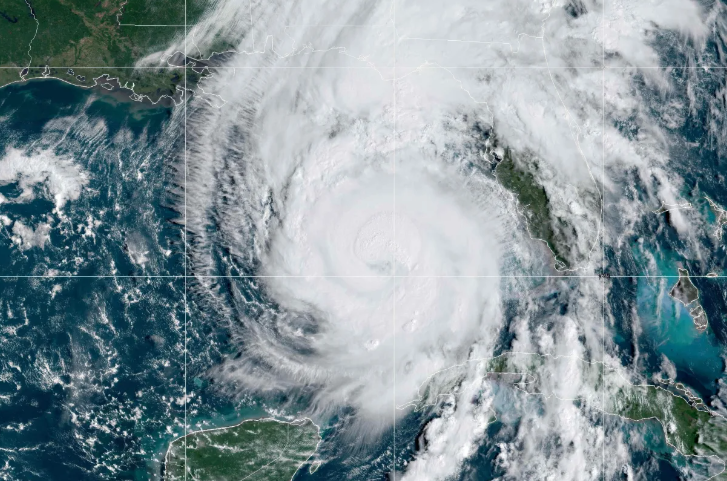Hurricane Helene has rapidly intensified into a Category 2 storm as it barrels toward Florida’s Gulf Coast. The National Hurricane Center (NHC) has issued life-threatening warnings about Helene’s impact, which is expected to make landfall tonight as a potentially catastrophic Category 4 storm. Floridians are bracing for significant damage, with 15 to 20-foot storm surges and intense winds forecasted along its path. The unusually large hurricane has triggered evacuation orders, and millions of people in its projected path are taking urgent precautions.
Hurricane Helene Strengthens as it Nears Florida
On Thursday morning, Hurricane Helene intensified into a Category 2 storm. However, meteorologists warned that the storm would rapidly strengthen throughout the day, reaching Category 4 status by the time it makes landfall in Florida’s Big Bend area tonight. The storm’s maximum sustained winds are already at 105 mph, and it’s moving north-northwest at 14 mph. According to the NHC, the hurricane is located about 255 miles southwest of Tampa and 290 miles south of Apalachicola, Florida.
The most concerning aspect of Helene is its size, with wind fields extending as far as 275 miles from the center. This means that the effects of the hurricane, including storm surges and heavy rainfall, will be felt far beyond the immediate landfall zone.
Life-Threatening Storm Surge and Evacuations
The NHC has warned that storm surges could reach up to 20 feet in certain parts of Florida’s Gulf Coast. Such surges pose an extreme threat to life and property, particularly in low-lying areas like Apalachee Bay. Florida Governor Ron DeSantis has urged residents in evacuation zones to leave immediately. “If you’re in North Florida, you still have time to get to a shelter, but you’ve got to do it now,” DeSantis said during a press briefing.
Evacuation orders have been issued across the state, and local officials are working around the clock to ensure residents in high-risk areas are out of harm’s way. The Federal Emergency Management Agency (FEMA) is coordinating disaster relief efforts, and President Joe Biden has already approved emergency declarations for Georgia, North Carolina, and Florida.
Impacts Already Being Felt in Florida
Even though Hurricane Helene has yet to make landfall, its effects are already being felt in parts of Florida. Flooding has been reported in Naples, and water from Tampa Bay has begun splashing over highways. With the storm’s massive size, the NHC predicts that tropical-storm-force winds will stretch across six states, including Florida, Georgia, Alabama, South Carolina, North Carolina, and Tennessee.
Naples Bay has crested and started to flood downtown Naples, Fl. @winknews #HurricaneHelene #FLwx #swfl @StormHour pic.twitter.com/WHS1sVXcHY
— Chuck 🇺🇲 🇺🇸 🚤🌞🐊🌴 (@chuckbender66) September 26, 2024
NASA Postpones SpaceX Launch
The impending arrival of Hurricane Helene has forced NASA to delay the launch of SpaceX’s rocket, which was scheduled to transport astronauts to the International Space Station. NASA announced that due to the size of the storm, high winds and rain were expected in the Cape Canaveral area, despite the storm making landfall on the opposite coast. The new launch window is expected to open no earlier than Saturday afternoon, depending on weather conditions.
What to Expect After Landfall
Helene’s impact won’t be limited to Florida’s Gulf Coast. According to the National Oceanic and Atmospheric Administration (NOAA), the storm’s rainfall is expected to extend well into the Appalachian Mountains, where up to 18 inches of rain could cause severe flooding. Areas like Tallahassee, Atlanta, and Asheville are particularly vulnerable due to already saturated ground from recent rainfall. Residents in these areas have been warned to prepare for flash flooding, landslides, and widespread power outages.
How to Stay Safe During Hurricane Helene
With catastrophic winds, storm surges, and inland flooding expected, it’s critical that residents in the storm’s path heed all evacuation orders and warnings. The NHC has advised people not to venture outside during the storm, especially at night, when the danger from debris and rising water is harder to detect.
Governor DeSantis reminded Floridians, “Do not try to do any work in the dark. Wait until daylight to assess any damage. You don’t know what hazards are out there.”
Hurricane Helene is shaping up to be one of the most destructive storms of the season, with catastrophic storm surges and flooding predicted. As the storm makes landfall tonight, its impact will be felt for hundreds of miles inland. Stay tuned for live updates and remember to follow all local and federal guidance to stay safe.



